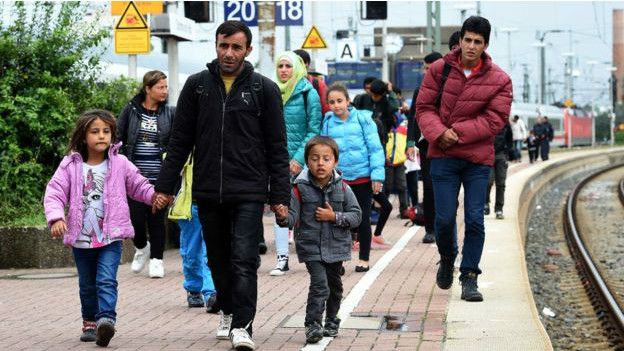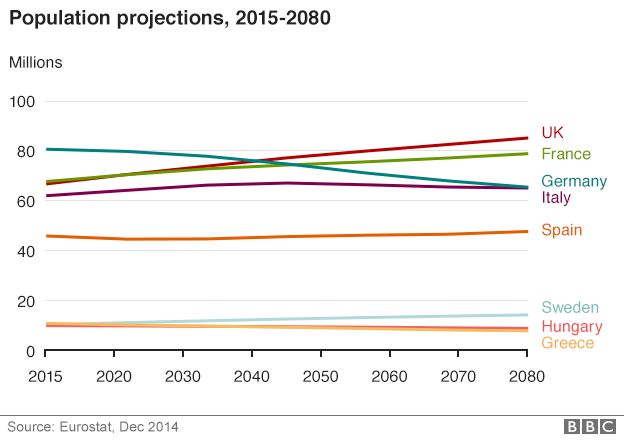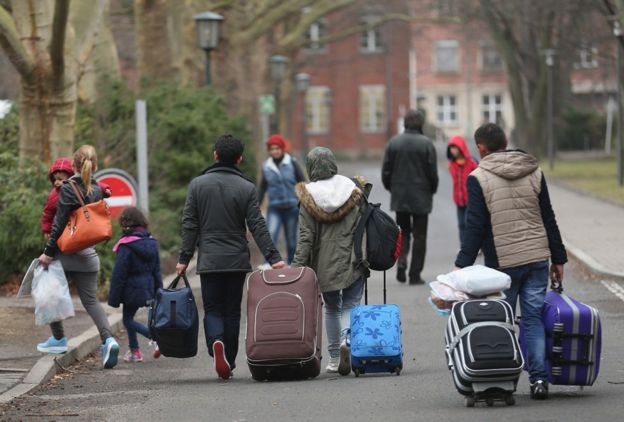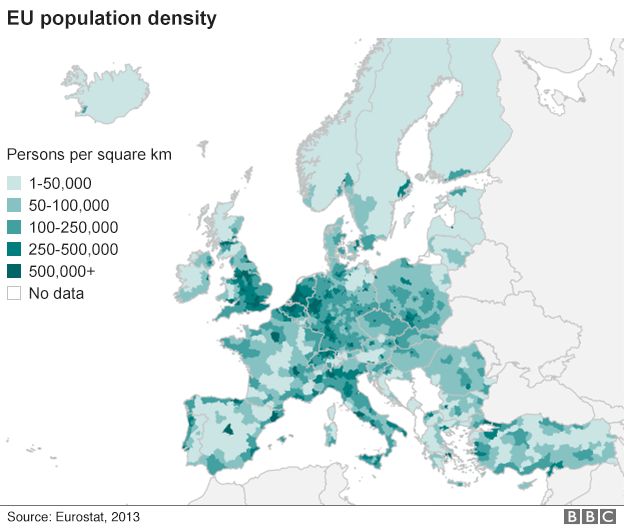Cómo se beneficiará Alemania al recibir a 800.000 inmigrantes | Which countries are in the best position to take migrants?
 EPAAlemania dijo que tiene la fortaleza para ayudar a los refugiados.
EPAAlemania dijo que tiene la fortaleza para ayudar a los refugiados.
Cuando Angela Merkel anunció la semana pasada que Alemania aceptará unos 800.000 buscadores de asilo este año en su país, muchos señalaron a los otros países del bloque europeo para que siguieran el "notable" ejemplo alemán.
Pero desde que comenzaron a llegar a las fronteras de Europa decenas de miles de emigrantes de Siria, África y Medio Oriente, la narrativa política en Alemania ha sido muy distinta de la que se ha escuchado en otros países de la Unión Europea.
La canciller alemana ha estado haciendo discursos sobre "los ideales europeos compartidos" y ha dicho que el continente como un todo tiene que comprometerse con el problema.
"Si Europa fracasa en el asunto de los refugiados, su cercana conexión con los derechos civiles universales quedará destruida", advirtió Merkel.
"Como país económicamente sano y fuerte, tenemos la fortaleza para hacer lo que sea necesario" declaró también.
Y en el país tanto los políticos de centro-izquierda como los de centro-derecha han apoyado, en general, su posición.
Para muchos de esos políticos, aceptar refugiados es un asunto de solidaridad con quienes huyen de la guerra y la persecución.
Pero para otros también hay claros motivos pragmáticos.
Motivos
Efectivamente, Alemania tiene una de las poblaciones que más rápido están envejeciendo y disminuyendo en el continente europeo.
Según las proyecciones de la Comisión Europea en su Informe sobre Envejecimiento, publicado el año pasado, se calcula que para 2060 el número total de alemanes se reducirá 10 millones: de 81,3 millones en 2013 a 70,8 millones.
 Getty
Getty
Es por eso que el país podría beneficiarse de un influjo de jóvenes trabajadores.
En contraste, se cree que Reino Unido se convertirá en el país más poblado de la UE. Según el informe de la Comisión, la población de Reino Unido se incrementará de 64,1 millones actualmente a 80,1 millones en 2060.
Esto como resultado de una tasa de fertilidad relativamente alta y las mayores tasas programadas de inmigración neta.
Una diferencia que puede ayudar a entender la diferencia en las posiciones de ambos países en el tema de migración.
Carga
En el caso alemán, la creciente proporción de ciudadanos dependientes anticipa una enorme carga para los contribuyentes.
Se calcula que el porcentaje de personas de 65 años y más frente a los pobladores de entre 15 y 64 años se incrementará de 32% en 2013 a 59% para 2060.
Esto quiere decir que para 2060 habrá dos alemanes menores de 65 años trabajando y generando impuestos por cada alemán mayor de 65 años.

Y por eso, para el editor de economía de la BBC, Robert Peston, "podría afirmarse que es particularmente útil para Alemania tener un influjo de familias jóvenes y agradecidas de Siria o de otras partes, que están dispuestas a trabajar duro y esforzarse para reconstruir sus vidas y demostrar a sus anfitriones que no son una carga".
Por supuesto, no todo serán buenas noticias para Alemania.
Un influjo masivo de emigrantes como el que se está viendo actualmente creaenormes desafíos para una sociedad.
Los gobiernos y autoridades locales, donde deben hospedarse los refugiados, se están viendo abrumados y no todos están preparados para albergar a decenas de miles de personas.
Y los sistemas de asistencia social y los presupuestos regionales enfrentarán enormes costos adicionales.
 Getty
Getty
Pero tal como señala en su edición internacional la revista Der Spiegel, la entrada sin precedentes de emigrantes que experimenta Alemania "cambiará fundamentalmente el país".
"(Los emigrantes) representan una carga, pero también son una oportunidad para crear una Nueva Alemania, una más cosmopolita y generosa".
Y la ola de inmigración también es bien recibida por los empresarios. "A pesar de que la cifra oficial de desempleo es de casi 2,8 millones en el país –dice Der Spiegel– la comunidad empresarial necesita urgentemente trabajadores".
"La economía alemana depende de la inmigración, tanto desde Europa como de personas que entran al país debido a los derechos de asilo en Alemania".
 .
.
"Con una población alemana que se reduce, las empresas no pueden ocupar muchos empleos y los trabajadores especializados son cada vez más raros. Esta tendencia se verá exacerbada en los próximos años. Es un hecho que pone en riesgo la futura prosperidad del país", dice la revista.
Y los expertos están de acuerdo en queAlemania no podrá satisfacer sus necesidades de trabajo sólo con el mercado laboral europeo, que permite el libre movimiento de trabajadores dentro de la UE.
Por supuesto que el debate de la inmigración siempre tendrá partidarios y opositores. Alemania no ha estado exenta de ataques y condenas de la extrema derecha.
Pero la mayoría de los economistas están de acuerdo en que la inmigración promueve el crecimiento, y Alemania está viviendo un momento en que la actual ola de emigrantes puede serle económica y demográficamente muy útil.
-------------------------------
Sobre la terminología: La BBC utiliza el término migrante para referirse a todas las personas en movimiento que todavía tienen que completar el proceso legal de solicitar asilo. Este grupo incluye tanto a las personas que huyen de países asolados por conflictos bélicos -como el caso de Siria- a quienes es muy probable que se le conceda el estado de refugiado, así como aquellos que buscan empleo y mejores condiciones de vida, que son propensos a ser catalogados como migrantes económicos.
Encontrarán más detalles sobre este debate en este artículo.
Contenido relacionado
Which countries are in the best position to take migrants?
European Union countries are promising to take more asylum seekers. But which might be best placed to allow more people in, in terms of their economy, existing population pressures and public services?
Population changes
In any consideration of the possibility of taking in large numbers of migrants, the impact of population increases is often mentioned. In the year to March, the UK had a record net migration figure of 330,000. By June last year, the UK's population had risen to just shy of 65 million.

The country is projected to undergo a uniquely large population increase. The EU suggests it will grow by more than two million between 2015 and 2020, reaching 66.7 million. It foresees increases to continue, with the population reaching 77.2 million by 2050 and 85.1 million by 2080. The UK is likely to become the EU's most populous member state, a status currently held by Germany.
France is also projected to expand its population consistently, to reach 78.8 million by 2080. Italy's population is projected to increase at a slower rate.
Another country, seeing large growth is Sweden, projected to grow from 9.7 million people to 14.1 million by 2080.
Germany, on the other hand, is projected to see a fall in population of about 67,000 between 2015 and 2020, to 80.6 million. By 2050, it would decline to 74.7 million and 65.4 million by 2080. This has led to fears that the country, which has seen adecline in its birth rate, might struggle to compete with economic rivals due to a lack of manpower. Others that seemingly face losing a large proportion of their populations include Greece, the Baltic states, Hungary and Romania.
 Getty Images
Getty Images
The population of the EU as a whole is projected to rise from 508.2 million in January this year to a peak of 525.5 million in 2050, falling to 520 million in 2080.
These numbers, it has to be remembered, are only projections and relying on population statistics alone might be deemed a crude way of looking at the situation. Falling populations, which could include a "brain drain" of young experts, might leave a country less able to deal with any greater strain of more people coming in.
Alternatively, the greater ageing of the population that remains in place could mean migrants are in more demand. This is said to be the case in Germany, for instance.
There has been debate over what forms the "optimum" population for any country. In the UK, the Migration Watch think tank has said efforts should focus on stabilising the UK population below 70 million, but Oxford University's Migration Observatory has questioned whether this is possible.
Academic study of migration has until now focused mainly on "qualitative" questions, such as ethical and political discussions over the subject, says Alexander Betts, professor of refugee and forced migration studies at Oxford University. There needs to be more concentration on the "metric" side of the question, particularly countries' capacities to take more people, he adds.
Betts also says a "responsibility-sharing index", detailing the needs and resources of different EU countries, would be useful, given recent developments.
Space
There is also the question of population density - how much space does each country have for more people to live in?

The EU member state with the smallest number of people per sq km, according to figures from 2013, is Finland - on 17.9, followed by Sweden, on 23.6. But much of land in these countries is not easily habitable because of extremes of cold or other geographical features.
Of the four largest EU countries, in terms of inhabitants, France is the least densely populated - with 103.8 people per sq km, followed by Italy on 199.4 and Germany on 230. The UK is more densely populated, with 264.3 per sq km (684.5 per square mile). These figures fail to take into account regional variations, with England, its south-eastern part in particular, more crowded.
This part of the UK is the most popular destination for new arrivals. The Migration Observatory found that London and south-east England accounted for almost half of England's increase in foreign-born residents between 2011 and 2015.
The most densely populated countries in the EU are Malta, with 1,339.8 people per sq km and the Netherlands, with 498.4 per sq km.
 Getty Images
Getty ImagesHousing
Population density figures look at the level of crowding in the country as a whole. But what are conditions like in the places where migrants are actually likely to live - towns and cities?
The European Union sets its own definition of overcrowding, based on the number of people per room in a household. By these criteria, the UK isn't among the most crowded places in the EU.
Romania comes off worst, with 55.1% of the population living in homes deemed overcrowded. Cyprus has the lowest proportion - 2.2%.
Of the large nations, Italy has by far the highest proportion of people living in overcrowded conditions - 31.3%. France is next, on 11.5%, followed by the UK on 11.1% and Germany on 10.4%.
But these figures don't show how things have changed over the past decade. The UK has seen the number of people living in overcrowded conditions rise by more than a half since 2005. It has increased slightly in Germany, while in France it has fallen.
These trends, as well as projected house building figures, would have implications for any country when deciding how many migrants it can take. The two countries projected to expand most rapidly in population terms - Sweden and the UK - are expected to suffer housing shortages.
Job vacancies and economy
Migrants usually arrive in a country expecting to work eventually. This is true for asylum seekers, as well as those moving for economic reasons. Job vacancy figures - the percentage of all jobs that are vacant - give an indication of how in demand a migrant is likely to be.

In this regard, Germany comes out on top. It has a job vacancy rate of 2.9%, according to the EU's latest figures. As it's also the largest of the 28 member states, this means it has the most positions to fill.
The UK comes second among the major EU economies, on 2.4%. Of the other large EU countries, Italy and France have rates of 0.7% and 0.6%. The lowest vacancy rate among the EU states is Latvia and Portugal's 0.5%.
The figures don't take into account the qualification levels of applicants and the breakdown of vacancies by skill level, but they provide a rough guide to the labour market situation.
"A lot of Syrians are very well educated because they've had opportunities," says Betts. "Somalis often haven't had those opportunities because they've lived in a failed state. It also depends on individuals. It's also worth saying that different EU economies have different needs for their labour markets."
More broadly, the UK's economy is expected to grow more quickly in the short term than those of its major EU competitors, with GDP increasing by 2.4% in 2016, according to the European Commission's latest forecast. The prediction for Germany is 2%, while it's 1.7% for France and 1.4% for Italy.
"If you have a growing economy then it's clearly in a better position to deal with things than if you have a stagnant economy," says Christian Dustmann, director of the Centre for Research and Analysis of Migration at University College London.
And then there's the black economy, which offers employment opportunities, even though much of it is illegal. In 2013, management consultancy firm AT Kearney estimated that Germany's was worth 351bn euros (£256bn), the biggest in the EU. Next was Italy's, worth 333bn euros, then France's (204bn euros) and Spain's (196bn euros). The UK's was fifth, worth an estimated 189bn euros.
Public services
Once people come to a country they need to access basic services, such as healthcare and education, sometimes immediately. There are often concerns that large numbers of migrants will put a strain on these, so it's worth looking at a couple of indicators, to see how much slack, if any, exists in the EU.
On healthcare, figures from the World Bank suggest Greece has the highest number of doctors per 1,000 population - 6.2 - of any EU country. But this figure was last updated in 2010.
The most recent UK figure, from 2013, is toward the lower end of the EU's table, with 2.8. Germany reported 3.9 in 2012, Italy 3.8, and France 3.2 in 2013. Poland was lowest, with 2.2, recorded in 2012.
The World Health Organization estimates that fewer than 2.3 health workers - not just doctors, but also nurses and midwives - per 1,000 population would be insufficient to cover primary healthcare needs.
| Pupils per primary school teacher | |
|---|---|
| UK | 21.1 |
| France | 18.9 |
| Germany | 16 |
| Italy | 12.1 |
| Luxembourg | 9.2 |
| Source: Eurostat (figures from 2012) | |
As for education, what is the capacity in the system to cope with more children? One indicator is the number of pupils per teacher in state primary schools. The UK has the most of any EU country, according to figures compiled in 2012, with 21.1. Of the other large EU countries, Germany has 16, France 18.9 and Italy 12.1. Luxembourg has the lowest number, with 9.2.
It's argued by many economists that having more working migrants means more tax coming in, allowing the expansion of public services, such as health and education, enabling governments to cope with increased demand.
"Whenever you have migration, you need to deal with resources," says Dustmann. "Denmark, Sweden and Germany in the past, when there was a large flow of migrants, took action to allocate them to different regions."
Other factors
But these practical factors are not the only considerations. The presence of migrant communities in some EU countries may make the process of integration easier. Language is also a major factor, and the nature of public attitudes towards migrants. Factors like the willingness of employers to consider migrants for jobs can be harder to measure.
Subscribe to the BBC News Magazine's email newsletter to get articles sent to your inbox. http://www.bbc.com/news/magazine-34138831

No hay comentarios.:
Publicar un comentario